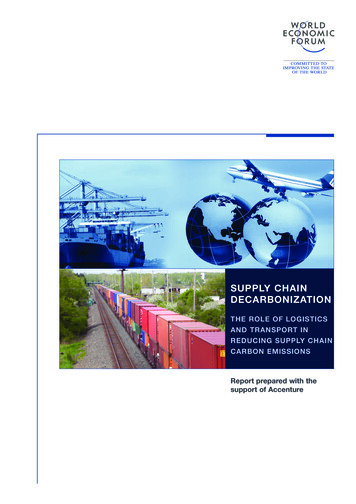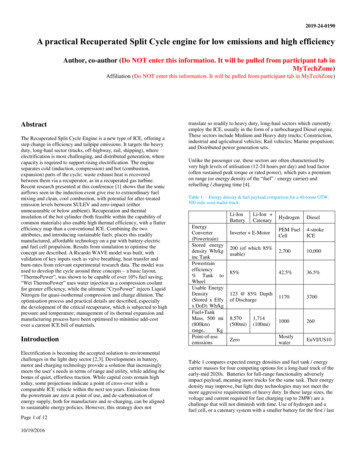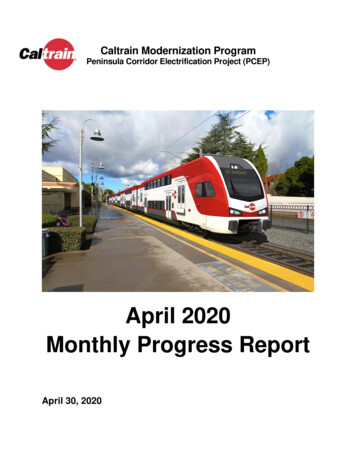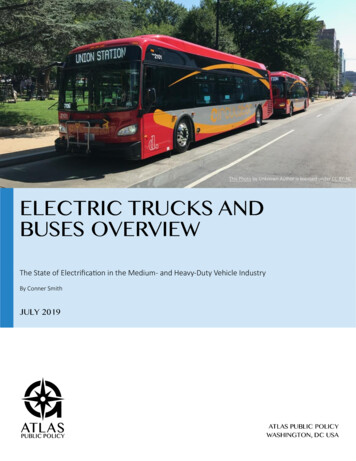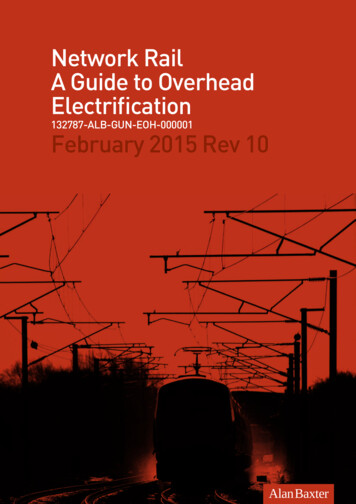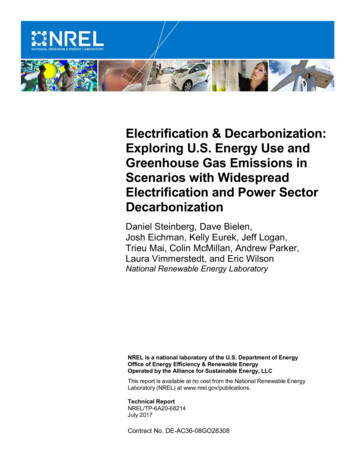
Transcription
Electrification & Decarbonization:Exploring U.S. Energy Use andGreenhouse Gas Emissions inScenarios with WidespreadElectrification and Power SectorDecarbonizationDaniel Steinberg, Dave Bielen,Josh Eichman, Kelly Eurek, Jeff Logan,Trieu Mai, Colin McMillan, Andrew Parker,Laura Vimmerstedt, and Eric WilsonNational Renewable Energy LaboratoryNREL is a national laboratory of the U.S. Department of EnergyOffice of Energy Efficiency & Renewable EnergyOperated by the Alliance for Sustainable Energy, LLCThis report is available at no cost from the National Renewable EnergyLaboratory (NREL) at www.nrel.gov/publications.Technical ReportNREL/TP-6A20-68214July 2017Contract No. DE-AC36-08GO28308
Electrification & Decarbonization:Exploring U.S. Energy Use andGreenhouse Gas Emissions inScenarios with WidespreadElectrification and Power SectorDecarbonizationDaniel Steinberg, Dave Bielen,Josh Eichman, Kelly Eurek, Jeff Logan,Trieu Mai, Colin McMillan, Andrew Parker,Laura Vimmerstedt, and Eric WilsonNational Renewable Energy LaboratoryPrepared under Task No. EP21.0205NREL is a national laboratory of the U.S. Department of EnergyOffice of Energy Efficiency & Renewable EnergyOperated by the Alliance for Sustainable Energy, LLCThis report is available at no cost from the National Renewable EnergyLaboratory (NREL) at www.nrel.gov/publications.National Renewable Energy Laboratory15013 Denver West ParkwayGolden, CO 80401303-275-3000 www.nrel.govTechnical ReportNREL/TP-6A20-68214July 2017Contract No. DE-AC36-08GO28308
NOTICEThis report was prepared as an account of work sponsored by an agency of the United Statesgovernment. Neither the United States government nor any agency thereof, nor any of their employees,makes any warranty, express or implied, or assumes any legal liability or responsibility for the accuracy,completeness, or usefulness of any information, apparatus, product, or process disclosed, or representsthat its use would not infringe privately owned rights. Reference herein to any specific commercialproduct, process, or service by trade name, trademark, manufacturer, or otherwise does not necessarilyconstitute or imply its endorsement, recommendation, or favoring by the United States government or anyagency thereof. The views and opinions of authors expressed herein do not necessarily state or reflectthose of the United States government or any agency thereof.This report is available at no cost from the National Renewable EnergyLaboratory (NREL) at www.nrel.gov/publications.Available electronically at SciTech Connect http:/www.osti.gov/scitechAvailable for a processing fee to U.S. Department of Energyand its contractors, in paper, from:U.S. Department of EnergyOffice of Scientific and Technical InformationP.O. Box 62Oak Ridge, TN 37831-0062OSTI http://www.osti.govPhone: 865.576.8401Fax: 865.576.5728Email: reports@osti.govAvailable for sale to the public, in paper, from:U.S. Department of CommerceNational Technical Information Service5301 Shawnee RoadAlexandria, VA 22312NTIS http://www.ntis.govPhone: 800.553.6847 or 703.605.6000Fax: 703.605.6900Email: orders@ntis.govCover Photos by Dennis Schroeder: (left to right) NREL 26173, NREL 18302, NREL 19758, NREL 29642, NREL 19795.NREL prints on paper that contains recycled content.
AcknowledgementsWe would like to thank the following individuals for their thoughtful reviews, comments, andsuggestions: David Mooney, Robin Newmark, Gian Porro, Mary Lukkonen, and Karin Haas ofthe National Renewable Energy Laboratory; Max Wei of the Lawrence Berkeley NationalLaboratory; Ryan Jones of Evolved Energy; Carla Frisch, Sarah Garman, and Erin Boyd of theDepartment of Energy’s (DOE’s) Office of Energy Policy and Systems Analysis; Steve Capanna,Paul Donohoo-Vallett, Kara Podkaminer, Jack Mayernik, John Stevens, Rachel Nealer, JacobWard, and David Gohlke of DOE’s Office of Energy Efficiency and Renewable Energy. Wewould also like to thank DOE’s Office of Energy Policy and Systems Analysis for primaryfunding support for this analysis. In particular, we are grateful to Carla Frisch for her support ofthis study. This research was funded in 2016 by the U.S. Department of Energy under contractnumber DE-AC36-08GO28308. Any errors or omissions are the sole responsibility of theauthors.iiiThis report is available at no cost from the National Renewable Energy Laboratory (NREL) at www.nrel.gov/publications.
PrefaceThis report, funded by the U.S. Department of Energy’s Office of Energy Policy and SystemsAnalysis, describes an initial analysis exploring the potential implications of widespreadelectrification of energy services in the buildings, transportation, and industrial sectors on thefuture evolution of the U.S. electricity system. Given its exploratory nature, the analysisconsiders only a limited set of electrification, efficiency, and power sector decarbonizationscenarios; in addition, estimates of the electrification potential of each end-use sector—buildings, industry, and transport—are based on a relatively aggregated analysis of end-useservice and fuel demands by sector and state and, therefore, do not consider explicittechnologies, adoption patterns, or other detailed issues that could ultimately affect results.Ongoing and potential future work is designed to apply a suite of higher-fidelity sector-specificmodels to address some of the same questions as posed in the exploratory analysis. This followon work will use a detailed accounting framework of energy use in all sectors, explore a largernumber of electrification technology options and scenarios, employ high-resolution sectorspecific bottom-up engineering models to project future electricity consumption patterns, andconduct detailed electricity system production cost modeling.This study contributes to a considerable body of work at the National Renewable EnergyLaboratory that explores the potential for clean energy and efficiency technologies, along withrelated research and development, demonstration, and deployment activities and policies, toaffect the future evolution and operation of the U.S. electricity system.ivThis report is available at no cost from the National Renewable Energy Laboratory (NREL) at www.nrel.gov/publications.
List of AcronymsAEOANLASHRAEBEVBFBLAST-VBOFCBECSCCUSCH 4CO 2CO 2 SSERATEFAnnual Energy OutlookArgonne National LaboratoryAmerican Society of Heating, Refrigerating andAir-Conditioning Engineersbattery electric vehicleblast furnaceBattery Lifetime Analysis and Simulation Tool forVehiclesbasic oxygen furnaceCommercial Buildings Energy Consumption Surveycarbon capture, utilization, and sequestrationmethanecarbon dioxidecarbon dioxide equivalentClean Power Planconcentrating solar powerU.S. Department of EnergyU.S. Energy Information AdministrationU.S. Environmental Protection AgencyElectric Power Research InstituteOffice of Energy Policy and System Analysiselectric vehiclefuel cell vehiclegreenhouse gasEPA’s Greenhouse Gas Reporting Programgross vehicle weight ratingheavy-duty vehiclehybrid electric vehiclefluorine-containing substancelight-duty vehiclemedium-duty vehiclemedium- and heavy-duty vehiclesmetric tonnitrous oxideNational Energy Modeling SystemNational Economic Value Assessmentnatural gas combined cycleplug-in hybrid electric vehiclesolar photovoltaicsResidential Energy Consumption SurveyRegional Energy Deployment SystemRenewable Electricity FuturesState Energy Data SystemScenario Evaluation and Regionalization AnalysisTransportation Energy FuturesvThis report is available at no cost from the National Renewable Energy Laboratory (NREL) at www.nrel.gov/publications.
Executive SummaryElectrification of end-use services in the transportation, buildings, and industrial sectors coupledwith decarbonization of electricity generation has been identified as one of the key pathways toachieving a low-carbon future in the United States. By lowering the carbon intensity of theelectricity generation and substituting electricity for higher-emissions fossil fuels in end-usesectors, significant reductions in carbon dioxide emissions can be achieved. This report describesa preliminary analysis that examines the potential impacts of widespread electrification on theU.S. energy sector. We develop a set of exploratory scenarios under which electrification isaggressively pursued across all end-use sectors and examine the impacts of achieving theseelectrification levels on electricity load patterns, total fossil energy consumption, carbon dioxideemissions, and the evolution of the U.S. power system.Using business-as-usual projections of end-use fuel and service demands as a starting point, wedeveloped scenarios of electrification for each end-use sector based on exogenously defined ratesof electrification and efficiency improvements for each end-use service. We then employ ahighly detailed power sector model to study the impacts of electrification on the U.S. powersector and on greenhouse gas (GHG) emissions. We simulate the evolution of the power systemboth with and without an assumed power sector cap on GHG emissions of 83% below the 2005level by 2050.Under the scenarios explored, widespread electrification of end-use services across thetransportation, buildings, and industrial sectors leads to a doubling of electricity consumption by2050, but moderate improvements in the energy efficiency of end-use devices can substantiallylimit the growth in load. Furthermore, despite driving large increases in total load, temporalflexibility in some end uses, such as hydrogen production for vehicles and electric vehiclecharging (as assumed in this study), can offset the increased peak demand in other end uses (e.g.,buildings) such that electrification has the potential to reduce variability or “peaky-ness” of load,which can aid in the integration of new resources—particularly variable renewable resources.Results from power sector modeling demonstrate that incremental load associated withelectrification is predominantly met with generation from new wind, solar, and natural gascombined cycle capacity and, to a lesser extent, with increased generation from existing naturalgas combined cycle capacity. However, when power sector emissions are capped at 83% below2005 levels by 2050, carbon capture, utilization, and sequestration (CCUS) technologies alsoplay a significant role in meeting demand.Aggregating effects to the economy level, we find that electrification of end uses, when coupledwith power sector decarbonization, has the potential to substantially reduce economy-wideemissions of carbon dioxide (CO 2 ) associated with fossil fuel combustion. Specifically, we findthat, by 2050, electrification and simultaneous power sector decarbonization can achievereductions of nearly 74% below the 2005 level of economy-wide fossil fuel combustionemissions. Furthermore, even in the absence of policies to lower the emissions intensity ofelectricity generation, electrification alone can have a significant impact on GHG emissions. Wefind that electrification, in the absence of any additional power sector carbon policy, can result in41% reductions (below 2005 level) in economy-wide fossil fuel combustion emissions.viThis report is available at no cost from the National Renewable Energy Laboratory (NREL) at www.nrel.gov/publications.
Despite this significant potential to reduce emissions, the level of electrification and the degreeof decarbonization explored in these scenarios are not, in isolation, sufficient to achievereductions in economy-wide GHG emissions of 83% below the 2005 level. Thus, pathways toachieving deep reductions in GHG emissions will necessarily involve additional strategies forreduction, but electrification and electricity decarbonization will play a large and important rolein achieving a low-carbon future. Future work is needed to understand other potentialimplications of widespread electrification and the challenges and risks associated withelectrification.viiThis report is available at no cost from the National Renewable Energy Laboratory (NREL) at www.nrel.gov/publications.
Table of ContentsIntroduction . 1Background . 2Methods. 8Electrification Projections . 9Transportation . 10Residential and Commercial Buildings . 12Industry . 13Generation and Transmission Expansion Simulation. 15Results and Discussion. 16Electricity Demand Impacts . 16Power System Evolution . 19Generation and Capacity . 19Variable Generation Curtailment . 24Prices and System Costs . 25Integrated Energy and Emissions Implications . 28Conclusions . 31References . 33Appendix. Detailed Methods for Electrification Potential Estimates and Development of the HourlyLoad Profiles . 37Residential and Commercial Buildings . 37Transportation . 39Industry. 42viiiThis report is available at no cost from the National Renewable Energy Laboratory (NREL) at www.nrel.gov/publications.
List of FiguresFigure 1. 2014 GHG emissions from fossil fuel combustion by sector (left) and by sector withemissions associated with electricity generation distributed to end-use sectors (right) . 3Figure 2. 2014 GHG emissions from fossil fuel combustion in the transportation sector . 5Figure 3. Industrial energy consumption as a fuel by end-use service and energy type (2010); dataexclude energy consumption as a non-fuel (feedstock). 6Figure 4. Final energy use in residential buildings by source and application—2009 residentialenergy consumption survey . 7Figure 5. Final energy use in commercial buildings by source and application—2012 commercialbuildings energy consumption survey . 8Figure 6. Total market penetrations of vehicle types from 2010 to 2050 for light-duty, and mediumand heavy-duty vehicles. . 11Figure 7. Reference and incremental electricity consumption from electrification by sector,2016–2050 . 17Figure 8. Peak-to-average demand ratio for the Reference, HighElec, and HighComb scenarios . 19Figure 9. Generation (top) and capacity (bottom) mix over time for the Baseline scenario (left) andthe difference between the Baseline-HighElec scenario and the Baseline scenario (right). 20Figure 10. Generation (top) and capacity (bottom) mix over time for the Baseline-HighElecscenario (left) and the difference between the Decarb-HighElec scenario and theBaseline-HighElec scenario (right) . 22Figure 11. Generation (top) and capacity (bottom) mix over time for the Baseline scenario (left)and the difference between the Baseline-HighComb scenario and the Baseline scenario (right) . 23Figure 12. Relationship between variable renewable resource penetration and average curtailment . 24Figure 13. Marginal (top) and average (bottom) electricity prices by decade for all scenarios. 26Figure 14. Carbon dioxide allowance prices over time for all scenarios . 27Figure 15. Projected carbon emissions from combustion of fossil fuels across all sectors and enduses analyzed . 29Figure A-1. Locations of the representative households simulated using the EnergyPlus model . 38List of TablesTable 1. Description of the Electrification Scenarios . 9Table 2. Annual Average Incremental Efficiency Improvement in Electric End-Use Devices from2017–2050 Assumed in the High-Efficiency Case. 13Table 3. Industrial End Uses and Electric Technologies Selected for Analysis . 14Table 4. Scenarios Simulated in the ReEDS Model . 16Table A-1. Residential and Commercial End-Use Services Represented in the NEMS Modela . 37Table A-2. Assumed Growth Rates of Electrotechnologies in Their Applicable Industries and byEnd Use . 43ixThis report is available at no cost from the National Renewable Energy Laboratory (NREL) at www.nrel.gov/publications.
IntroductionOpportunities and pathways to achieving deep reductions (60%–80%) in U.S. greenhouse gas(GHG) emissions have been explored in a number of studies (Wei et al. 2013; Williams et al.2014; EOP/CEQ 2016; Clarke et al. 2014). These analyses demonstrate that large emissionsreductions are achievable through a broad range of opportunities, including increased end-useenergy efficiency, decarbonization of electricity supply, increased reliance on low- or zerocarbon energy sources, use of carbon capture, utilization, and sequestration (CCUS)technologies, and substitution of traditional fossil-fuel-based industrial feedstocks with low- orzero-carbon alternatives. In particular, electrification of technologies across end-use sectors(transportation, residential and commercial buildings, and industry) coupled withdecarbonization of the power sector has been identified as one of the key components toachieving deep cuts in GHG emissions (Williams et al. 2014) due to the low cost and wide set ofoptions for reducing power sector emissions. Assuming rapidly decreasing carbon emissionsintensity of electricity generation and replacing fossil-fueled technologies with electrictechnologies can lead to significant reductions in GHG emissions related to direct fuelcombustion.The analysis presented in this report takes a closer look at this high-electrification pathway inorder to gain insights on:1. The potential to reduce carbon dioxide (CO 2 ) emissions through coupled decarbonizationof the power sector and widespread electrification of end-use processes 1 across the U.S.economy2. How the power sector may evolve to meet the rapidly growing demand for electricitywhile simultaneously reducing power sector GHG emissions3. How increased end-use efficiency can mitigate the necessary investment in the powersector to meet the growing electricity demand.We explore the potential for electrification and associated emissions reductions through ananalysis of fuel and end-use service consumption in each of the end-use demand sectors:transportation, buildings, and industry. Subsequently, using the results from the sectoral potentialanalyses as inputs, we employ a highly regional and temporally detailed model of the powersector using the Regional Energy Deployment System (ReEDS) 2 to simulate the buildout andoperation of the electric system under this high-demand future. We explore a scenario in whichelectrification is coupled with additional power sector emissions limits and one in which onlycurrently existing policies are maintained, as well as scenarios in which end-use efficiencyimprovements decrease the electricity intensity of end uses.We demonstrate that there is a large potential to reduce economy-wide fossil fuel combustionemissions through electrification of end-use services, particularly when electrification is coupled1End-use processes refer to the conversion of energy into an energy service, such as converting gasoline intomobility or transportation or electricity into air conditioning.2More information about the ReEDS model can be found in the documentation (Eurek et al. 2016; Short et al. 2011)as well as in numerous papers that rely on the model (Cole et al. 2016a, 2016b; Mai et al. 2016a, 2016b, 2014; Lantzet al. 2014, Mignone et al. 2012).1This report is available at no cost from the National Renewable Energy Laboratory (NREL) at www.nrel.gov/publications.
with decarbonization of the electric sector. However, in isolation, this approach may not besufficient to achieve economy-wide GHG reductions of 83% below the 2005 level. As a result,additional GHG abatement options, such as increased use of biomass- or hydrogen-based fuels(for both energy and feedstocks), CCUS, and/or nuclear energy for industrial thermal processesmay be required to achieve this deeper reduction goal. Finally, we demonstrate that moderateincreases in end-use efficiency can substantially reduce the power system investment required tomeet the growing electricity demand under the highly electrified future.While this study focuses on the potential for and impacts of a high electrification pathway, we donot assess the risks or barriers to electrification or the cost associated with the infrastructureinvestments (e.g., vehicle charging stations) outside of the power sector that would be necessaryto support electrification of end uses. Furthermore, we do not compare these scenarios toalternative GHG abatement pathways and, as a result, we do not judge or evaluate the likelihoodof these pathways or their merit relative to other strategies. Achieving a low-carbon future atlowest cost will likely require a multi-faceted approach involving electrification and a suite ofother abatement options that are not the focus of this study.BackgroundIn 2014, combustion of fossil fuels accounted for the large majority—approximately 76%—ofthe total 6,870 million metric tons (Mt) of carbon dioxide equivalent (CO 2 -e) emissions in theUnited States (EPA 2016a). 3 Electrification of end-use technologies and simultaneousdecarbonization of electricity generation is one approach to reducing these combustion-relatedGHG emissions. By substituting the use of fossil fuels, including coal, natural gas, andpetroleum-based fuels, with (increasingly) lower carbon intensity generation sources, 4electrification and power system decarbonization can reduce emissions associated with fossilfuel combustion in end-use sectors. Given that the carbon intensity of electricity has beendeclining in recent years even in the absence of measures to lower the carbon intensity of thegrid, electrification of some end uses can still yield emissions savings. 5 In addition, anyreductions in fossil fuel consumption associated with electrification could lead to reductions indomestic coal, oil, and natural gas production and transmission and result in reduced upstreamemissions. 6 Our analysis focuses on combustion-related emissions only, but we note that theseupstream emissions can be significant—they comprise 7% of 2014 U.S. GHG emissions(EPA 2016a).Combustion-related GHG emissions, predominantly CO 2 but also including CH 4 and N 2 O, aredistributed across all sectors of the economy, with the power sector historically the largest sourceof GHG emissions in the United States (Figure 1). In 2014, the power sector comprisedapproximately 39% of the 5,216 Mt of CO 2 -e combustion-related emissions nationally, followed3GHG emissions include CO2, methane (CH4), nitrous oxide (N2O), and fluorine-containing substances (HFCs).Lower-intensity generation sources include nuclear, renewable, and fossil fuel with CCUS technologies.5See, for instance, (Elgowainy et al. 2010; McLaren et al. 2016), comparing electric and conventional vehicleemissions under different grid intensities.6However, the extent to which these upstream emissions are reduced will depend on fossil fuel exports to othercountries. Conversely, reduced fossil fuel consumption could reduce upstream emissions from production outsidethe United States.42This report is available at no cost from the National Renewable Energy Laboratory (NREL) at www.nrel.gov/publications.
by transportation (34%), industry (15%), and residential and commercial buildings (11%) (EPA2016a). Given the large share of emissions from the power sector, decarbonization of electricitygeneration alone could have a significant impact on economy-wide emissions. For example,reducing the emissions intensity of generation by 80%, a level demonstrated to be achievable in awide range of studies (Mai et al. 2014; MacDonald et al. 2016), would result in a reduction ofalmost 1,650 Mt of CO 2 —24% of total U.S. GHG emissions (and almost one-third ofcombustion emissions). Coupling decarbonization of the grid with electrification of end-useprocesses has the potential to address an even larger share of combustion-related GHGemissions.Source: Environmental Protection Agency (EPA) Greenhouse Gas Inventory (EPA 2016a)Figure 1. 2014 GHG emissions from fossil fuel combustion by sector (left) and by sector withemissions associated with electricity generation distributed to end-use sectors (right)Electrification has the potential to address the direct combustion emissions associated with enduse services in the transportation, industrial, 7 and buildings sectors, which accounted for3,158 Mt CO 2 -e emissions, or 46% of total U.S. GHG emissions in 2014 (EPA 2016a). Thetransportation sector made up the largest share of direct combustion emissions (1,754 Mt CO 2 -e)and, as a result, has a large potential for direct emissions reductions (EPA 2016a). Furthermore,Figure 1 demonstrates that emissions in the transportation sector are almost entirely due to directfossil fuel combustion. Thus, given sufficient feasibility to substitute electric vehicles (EVs) forconventional vehicles and lowering carbon intensity of the grid, electrification in thetransportation sector could represent a large potential for GHG reductions.7Combustion emissions comprise just over 52% of total emissions in the industrial sector. Direct processemissions—for example, those from natural gas and petroleum systems and those emitted during iron and steelproduction—make up the remaining.3This report is available at no cost from the National Renewable Energy Laboratory (NREL) at www.nrel.gov/publications.
As shown in Figure 2, on-road vehicles are responsible for the majority of transportation-relatedGHG emissions. In particular, emissions from light-duty vehicles (LDVs), which includepassenger cars and light-duty trucks, totaled approximately 1,060 Mt CO 2 (61% of total sectorcombustion emissions) while emissions from medium- and heavy-duty vehicles (M/HDVs 8)totaled an additional 403 Mt CO 2 (23% of total sector combustion emissions). Combustionemissions from all other transport modes together made up the remaining 16% of totaltransportation sector combustion emissions (EPA 2016a; Davis et al. 2016).In this analysis, we only explore the electrification of LDVs and M/HDVs. Electrification ofthese vehicle classes is assumed to be achieved by replacing conventionally fueled vehicles—those that use petroleum-based fuels such as gasoline and diesel—with a range of alternativevehicles including plug-in hybrid electric vehicles (PHEVs), battery electric vehicles (BEVs
with decarbonization of electricity generation has been identified as one of the key pathways to achieving a low-carbon future in the United States. . and industrial sectors leads to a doubling of electricity consumption by 2050, but moderate improvements in the energy efficiency of end-use devices can substantially limit the growth in load. .
